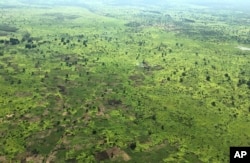A pilot program that paid landowners in Uganda to not cut down trees was successful, according to researchers looking for ways to try to reduce carbon emissions.
The researchers used interviews, periodic inspections and satellite images to monitor forests around 121 villages over two years. In 60 villages, they offered landowners $28 every year for each hectare of forest they preserved.
Deforestation is responsible for about one-tenth of global carbon emissions, according to the Union of Concerned Scientists, and leaving trees in place is one of the most cost-efficient options for capturing carbon. But it is hard to show it is effective.
“If you put up solar panels, you can say, ‘Ha! I put in those solar panels. Please give me my credits towards my target.' If you slow deforestation … it's harder to really know what impact you had,” co-author Seema Jayachandran, an economist at Northwestern University, told VOA.
Uganda deforestation
The study was conducted by researchers at Northwestern and a Dutch organization named Porticus. Uganda was an ideal location to attempt the program because between 2005-2010, the country had one of the highest rates of deforestation in the world, with a 2.7 percent loss each year.
Researchers wanted to address concerns that payments wouldn't actually reduce deforestation, either because participants in the program wouldn't have harvested trees anyway, they would just harvest more from other unprotected forest or they would quickly harvest immediately after the end of the program.
The study, published in the journal Science, found that there was less than half as much deforestation around villages in the program than around the control villages. Researchers found that villages in the payment program had preserved 5.5 more hectares of forestland than other villages.
And after the program ended, there was not a rush to cut down trees, so the benefits of the program lasted.
However, because the study was small, relative to the size of the national timber and charcoal markets, researchers were not able to see its effect on those markets. Without that information, they were not able to demonstrate that reduced deforestation in the study region didn't lead to increased deforestation elsewhere.
Reasons for deforestation
Jayachandran said a program like this would do best if it was paired with efforts to address the reasons for deforestation. These could be helping people in cities get stoves, so they aren't cooking with charcoal, or teaching farmers how to grow more food in less space, so they don't need to clear as much forest for crop land.
The researchers hope that governments trying to meet their carbon emission targets under the 2015 Paris Agreement will consider paying poorer countries to reduce deforestation. The Paris accord on climate change aims to keep average world temperatures from rising more than 2 degrees Celsius above pre-industrial times.
Program was popular
Jayachandran told VOA that humanity can't afford to ignore any opportunity to reduce carbon emissions.
The program was administered by the Chimpanzee Sanctuary and Wildlife Conservation Trust. The Chimpanzee trust talked to participants about other ways to make a livelihood from the forest such as bee keeping or growing mushrooms, and about the benefits of preserving forest land.
Lilly Ajarova, executive director of the trust, said the program was very popular with participants.
“The challenge we have at this point is that there has been no continuity,” Ajarova said. The program will need to be more long term in order for it to have “real economic benefits, not just for the people involved but for the whole nation.”








